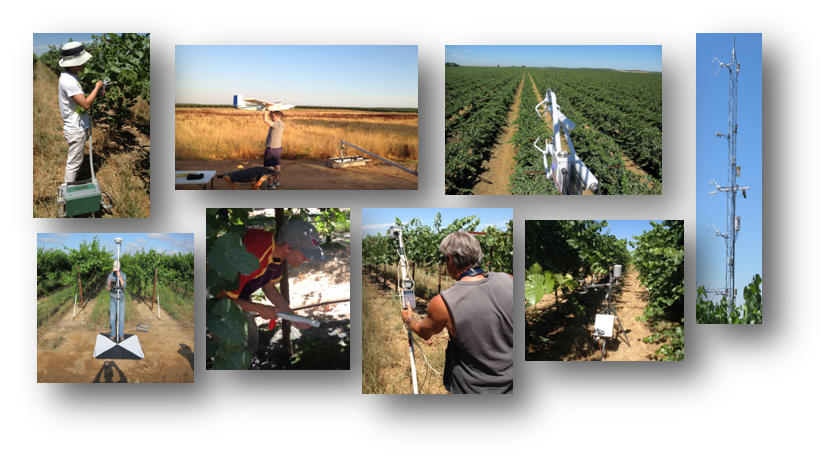| GRAPEX Overview |

|
Relevance
In California, grapes represent nearly 1 million acres of production valued at approximately $6 billion, while fruit and nut orchards represent an additional 2.6 million acres with crops valued in excess of $10 billion. To sustainably continue irrigated agriculture production in this region, better tools for managing water use are needed.
Approach
Development of such tools has been the focus of the ongoing GRAPEX project, led by USDA-Agricultural Research Service working collaboratively with Utah State University and Ernest & Julio Gallo Wineries. During the 2013 to the 2016 growing seasons, micrometeorogical, biophysical and remote sensing data from ground, airborne (including UAVs) and satellite platforms have been collected in adjacent pinot noir vineyards at different levels of maturity near Lodi, CA.

Aim
The aim of GRAPEX is to combine in-situ and remotely-sensed data to investigate the effects of canopy structure and row orientation on energy and moisture exchange processes within and above the vine canopy, and to incorporate these effects within the operational ET modeling system. A critical component of GRAPEX has been to work closely and collaboratively with scientists at Gallo to ensure that both the experimental data being collected and the models and tools being developed can address critical operational needs.
Preliminary Results
Preliminary results estimating ET at multiple scales are encouraging for these highly structured canopies and studies are underway to assess the utility of very high resolution UAV imagery for identifying important features in the field affecting vine growth and development.


Benefits to Stakeholder
For E&J Gallo and the other vineyard managers in the Central Valley, the primary needs are: i) determining the appropriate timing to initiate irrigation in the spring based on defined soil moisture/ET thresholds and ii) determining the amount of irrigation water to apply on a weekly basis necessary to achieve grape production and wine quality objectives. While other ET tools are currently used by Gallo, they lack key mechanisms and processes to address these important management questions. The ET toolkit being developed under the GRAPEX project will address these critical needs.
In 2017 the GRAPEX project will extend observations both north (Barrelli vineyard) near Cloverdale, CA and south (Ripperdan vineyard) near Madera, CA of the current vineyards (Borden vineyard) near Lodi, CA. This provides a significant climate gradient with degree day accumulations (DD) for the growing season of 2500 DD for Barrelli, 3700 DD for Borden, to 4200 DD for Ripperdan. In addition, three different varieties and trellis designs are used providing a wide range in canopy structure and vine physiology.

| < Back to Home | On to Measurements > |
